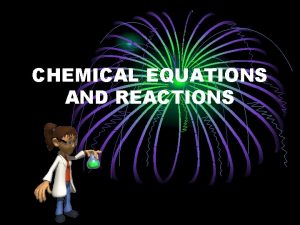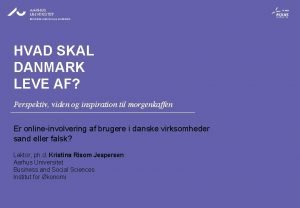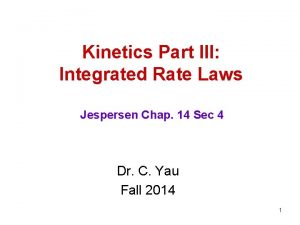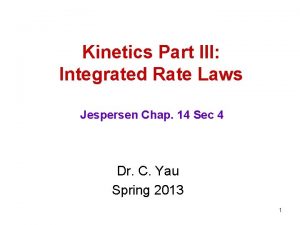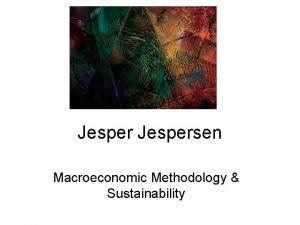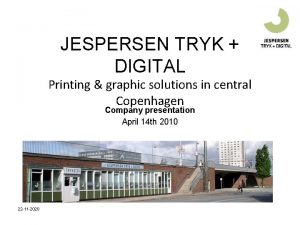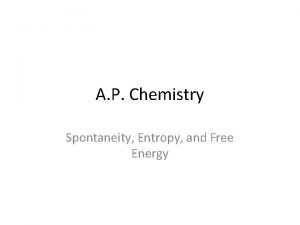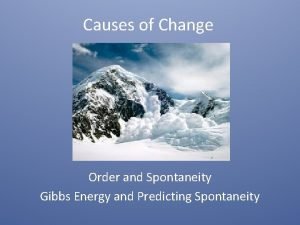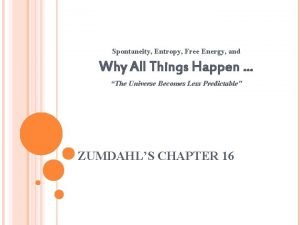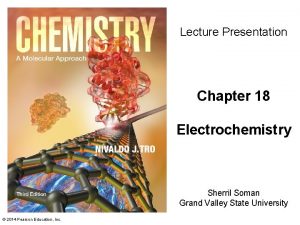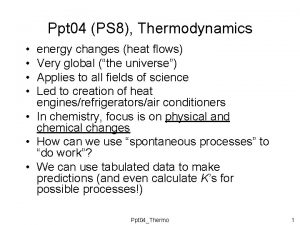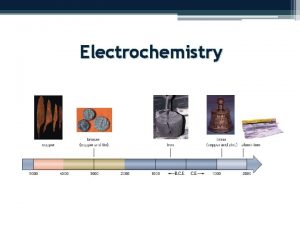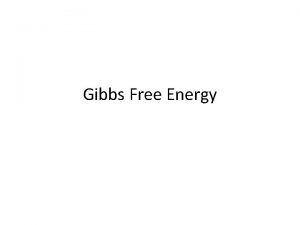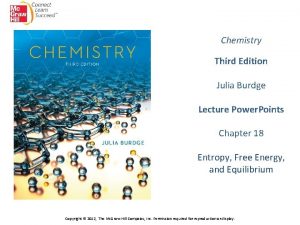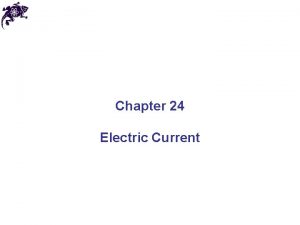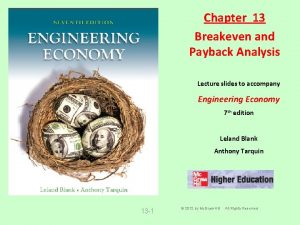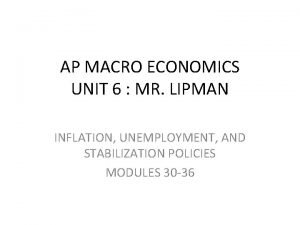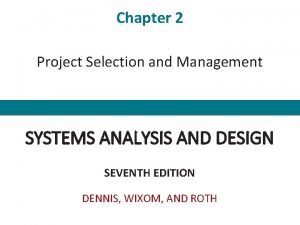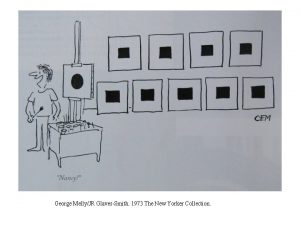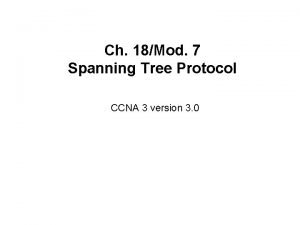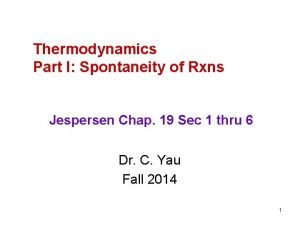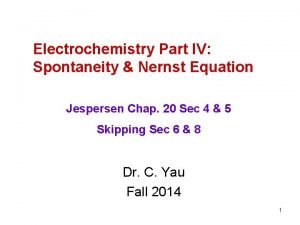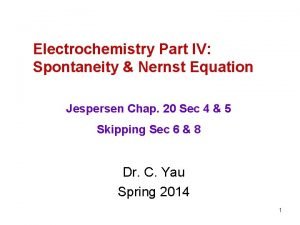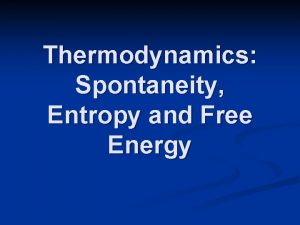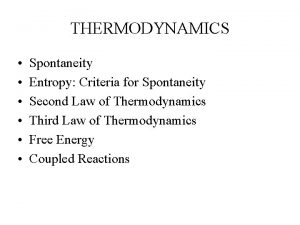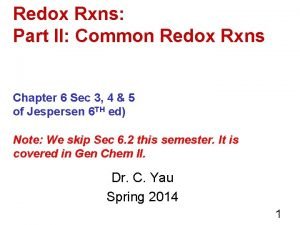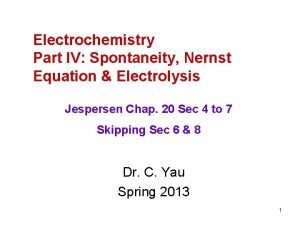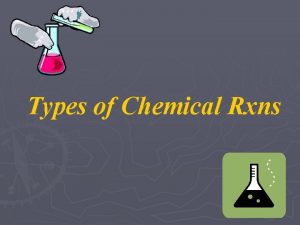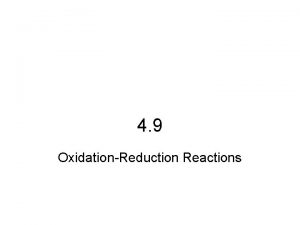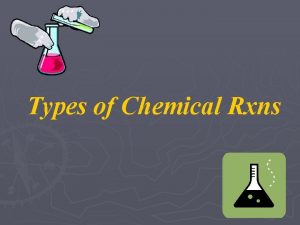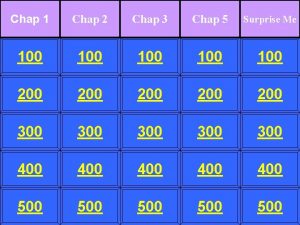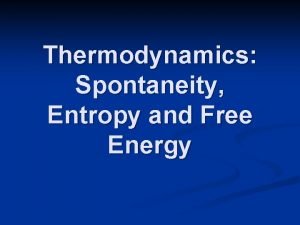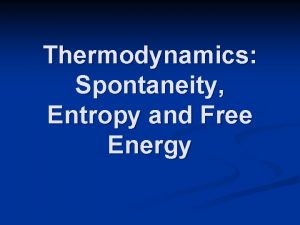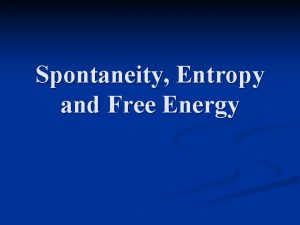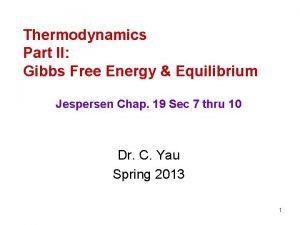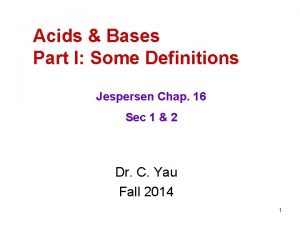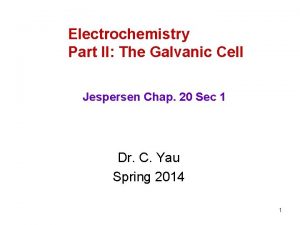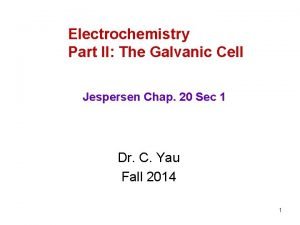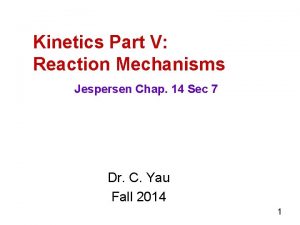Thermodynamics Part I Spontaneity of Rxns Jespersen Chap





































- Slides: 37

Thermodynamics Part I: Spontaneity of Rxns Jespersen Chap. 19 Sec 1 thru 6 Dr. C. Yau Spring 2014 1

First Law of Thermodynamics The first law of thermodynamics states that internal energy (E) may be transferred as heat (q) or work (w) but it cannot be created or destroyed. ΔE = q + w Whatever is not part of the system (sys) is part of the surroundings (surr), and together they constitute the universe (univ): Euniv = Esys + Esurr Since E cannot be created nor destroyed, ΔEuniv = 0 = ΔEsys + ΔEsurr Rearrangement gives… ΔEsys = – ΔEsurr 2

First Law of Thermodynamics • E = internal energy of a system (the sum of the kinetic and potential energy of all its particles) • ΔE = change in the internal energy of system = Eproducts – Ereactants • ΔE = q + w heat work • w = - PΔV where P is atmospheric pressure and ΔV is change in volume • w is called "PV work. " 3

First Law of Thermodynamics • w = – PΔV In an exothermic rxn, part of the heat released is used in heating the surrounding gas, which expands and pushes back the atmosphere. Expansion means Vfinal > Vinitial and ΔV = Vfinal – Vinitial , and so ΔV is positive. Volume is increasing, getting larger. and w = – PΔV is negative. (P and ΔV are both positive. ) • Negative w means work is done BY the system, on the surrounding. Internal E of the system is decreased (consistent with the sign. ) 4

Work (w) = – Patm·ΔV • In reactions, work is most often due to the expansion or contraction of a system caused by a change in the moles of gases. • The deployment of an airbag is one example of this process 1 C 3 H 8(g) + 5 O 2(g) → 3 CO 2(g) + 4 H 2 O(g) 6 moles of gas → 7 moles of gas • Since PV=n. RT, PΔV= Δn. RT. • Thus, we can predict the work: w= - PΔV = - Δn. RT (where Δn = 1 for example above)5

Some airbags contain sodium azide: Na. N 3. Did you know it is incorrect to hold wheel at 10 -2?

First Law of Thermodynamics What the + and – signs mean. . ΔE = q + w q is + heat is absorbed by the system q is – heat is released by the system w is + work is done on the system w is – work is done by the system ΔE is + internal energy is increased ΔE is – internal energy is decreased 7

q versus ΔH q. P is transfer of heat when at constant pressure (when rxn is in an open vessel) q. V is transfer of heat when at constant volume (when rxn is in a steel container and so V cannot change) For constant P, H (enthalpy) is defined as H = E + PV and ΔH = ΔE + PΔV rearrangement gives ΔE = ΔH – PΔV but we also know that ΔE = q + w = q + (-PΔV) ΔH – PΔV = q + (-PΔV) simplifies to ΔH = q. P 8

q versus ΔH When V is constant, ΔV = 0 and so PΔV = 0 ΔE = q + w ΔE = q – PΔV becomes ΔE = qv Summary: At constant P, q. P = ΔH At constant V, qv = ΔE 9

ΔH = enthalpy change = Hfinal – Hinitial ΔH + ΔH – endothermic, heat is absorbed exothermic, heat is released H H products reactants products It would seem exothermic rxns are spontaneous and endothermic rxns are non-spontaneous. 10

Spontaneous Changes A spontaneous change = change that occurs by itself without an ongoing input of energy from outside the system The burning of a match is spontaneous. Once it is lit, it will burn without further intervention. An ice cube melting at room temp is spontaneous…. BUT it is endothermic! Heat has to be ADDED. Why is it spontaneous? ? 11

Entropy (S) is the degree of disorder. ΔS = change in entropy = Sfinal – Sinitial When a system becomes more disorderly. . . order disorder, chaos smaller S larger S ΔS = Sfinal – Sinitial > 0 (positive) ΔS is + for a process that ends up more disordered. 12

Entropy (S) • Entropy is a measure of randomness • The more possible arrangement of particles, the higher the entropy • Processes favor high probability (p) Less ways to distribute E Spontaneous process More ways to distribute E Spontaneous processes tend to disperse energy. 13

Entropy (S) • The greater the number of energetically equivalent versions there are of a system… • the larger is the statistical probability… • therefore the larger the value of the entropy (more randomness) Fig. 19. 7 p. 877 Paper currency: 2 ways to count out $2. 00. Coins: 5 ways to count out $2. 00 using 50¢ and 25 ¢. Counting with coins has higher entropy than counting with 14 paper money.

Which of the following has the most entropy in standard conditions? A. H 2 O(l) B. Na. Cl(aq) C. Al. Cl 3(s) D. Can’t tell from the information Which system has more disorder? 15

Entropy Change with + Sign REMEMBER: ΔS is positive if we end up with more disorder What kind of changes lead to positive ΔS? Energy of motion becomes more dispersed (spread out more). • Volume (of gas) increases • Phase changes (solid to liquid to gas) • Dissolving a salt (solid to solvated ions) • Chem rxns where solid changes to gas; gas to more molecules of gas. • Increase in number of particles • Increase in number of bonds 16

Factors Affecting Entropy (ΔS) • Mixing • Volume change of gas • Change in physical state 17

In general, increase in temperature leads to larger disorder (larger entropy). At 0 Kelvin (absolute zero), particles are essentially motionless (S = 0). As T increases, motion increases and S increases. 18

Fig. 19. 11: Entropy is affected by number of particles. Rxn that produces more particles will have a positive S (more spontaneous). 19

Predict The Sign Of Δ S In The Following: • • + Dry ice →carbon dioxide gas Moisture condenses on a cool window + AB →A + B A drop of food coloring added to a glass of water disperses + • 2 Al(s) + 3 Br 2(l) → 2 Al. Br 3(s) - 20

Example 19. 2 p. 880 Predict the algebraic sign of ΔS for the rxns: a) 2 NO 2 (g) N 2 O 4 (g) negative b) C 3 H 8 (g) + 5 O 2 (g) 3 CO 2 (g) + 4 H 2 O (g) # molecules of gas increased ΔS is positive. Do Pract Exer 5, 6, 7 p. 880 21

Second Law of Thermodynamics states that all real processes occur spontaneously in the direction that increases the entropy of the universe (system plus surroundings). Whenever a spontaneous event takes place in our universe, the total entropy of the universe increases. ΔStotal > 0 (positive) The entropy of the universe is constantly rising. 22

Third Law of Thermodynamics The Third Law of Thermodynamics states that a perfect crystal has zero entropy at absolute zero. Ssys = 0 at 0 K Unlike enthalpy H which cannot be measured (only ΔH can be measured), entropy S can be determined. So = entropy at standard state (what are the conditions of standard state? ) 1 atm; at specified temp, usually 25 o. C; if aqueous, at 1 M concentration. REMEMBER! 23

Calculating S from S Similar to calculating H from H f we can calculate S from S of the reactants and products: S = n S (products) - n S (reactants) Where n = coefficient in balanced eqn, taking into account # moles of each product/reactant. n has units of moles S usually has units of J/(mol. K) (not k. J/(mol. K)) Thus, n S has units of. . ? 24

Hess’ Law Quick review on Hess’ Law and enthalpy change from Gen Chem I: H° = (sum of n Hf° products sum of n Hf° reactants) where n = # moles = coefficient in balanced eqn. What exactly is Hf°? IMPORTANT TO KNOW! It is the enthalpy change for the formation of one mole of substance from its elements at standard states: 25 o. C, 1 atm, 1 M if aqueous soln. Write the corresponding chem eqn for Hf° of… a) Ca 3(PO 4)2 (s) b) SO 2 (g) c) Br 2 (l)

Example 19. 3 p. 885 Urea ( a cmpd found in urine) is manufactured commercially from CO 2 and NH 3. One of its uses is as a fertilizer where it reacts slowly with water in the soil to produce ammonia and carbon dioxide. the ammonia provides a source of nitrogen for growing plants. CO(NH 2)2 (aq) + H 2 O (l) CO 2 (g) + 2 NH 3 (g) What is the standard entropy change when one mole of urea reacts with water? p. 885 -Table 19. 1 gives standard S values, but Appendix C (p. A-40) gives a very extensive table of thermodynamic values (including ΔHfo and ΔGo values). See next slide. 26

CO(NH 2)2 (aq) + H 2 O (l) CO 2 (g) + 2 NH 3 (g) Substance So (J/mol K) CO(NH 2)2 (aq) 173. 8 H 2 O (l) 69. 96 CO 2 (g) 213. 6 Ans. 354. 8 J/K NH 3(g) 192. 5 Pay attention to the physical states! H 2 O (g) 188. 7 and O 2 (g) 205. 0 NOT ZERO! Do Pract Exer 9 & 10 p. 887 27

Putting it all together… Gibbs free energy (G) = H – TΔS At constant T and P, Gibbs free energy change ΔG = ΔH - T ΔS Learn this!! ΔG = Gfinal - Ginitial ΔG, ΔH, ΔS are all state functions. (They are dependent only on their initial and final states and not the pathway of getting there. ) A reaction is spontaneous if ΔG is negative. (Gfinal is less than Ginitial) 28

Prediction of Spontaneity Negative G = process is spontaneous Negative H (exothermic) LEARN THIS NOW! promotes spontaneity. Positive S (towards more disorder) promotes spontaneity. So, an exothermic reaction that leads to more disorder would be a spontaneous rxn. T always positive. . WHY? ΔG = ΔH - T ΔS Negative Positive 29

Gibbs Free Energy & Spontaneity ΔG = ΔH - T ΔS Note the role of temperature (T). It determines how important the S term is to be. At high T, the entropy factor plays an important role. If S is + (promoting spontaneity), at high T, the rxn is said to be “entropy driven. ” If S is - & H is - ( H, not S, is promoting spontaneity), at low T, the rxn is said to be “enthalpy driven. ” Before we do the calculations, let's examine the conditions when ΔG is negative. What is the significance of it being neg. ? 30

G° = H° T S° Remember rxn is spontaneous when G° = • H° = - and S°= + exothermic • H° = - and S°= - • H° = + endothermic G°= - at all temp to more disorder exothermic • H° = + - G°= - at low temp to less disorder (at low T, rxn is “enthalpy driven”. ) and S°= - G°= + at all temp to less disorder and S°= + G°= - at high temp to more disorder (at hi T, rxn is “entropy driven”. ) When H° and S° have the same sign, spontaneity is determined by the temperature. 31

Fig. 19. 13 p. 884 When H° and S° have the same sign, spontaneity is determined by the temperature. 32

Gibbs Free Energy & Spontaneity You did this type of calculation in Paper HW#5 already. You can calculate ΔG by 2 methods: (depending on which information is available) 1) G° = ( of n Gf° of products) ( of n Gf° of reactants) where n = # moles = coefficient in balanced eqn. 2) G° = H° T S° where H° = ( of n Hf° products of n Hf° reactants) S° = ( of n. S° products n. S° reactants) 33

Calculate ΔG 0 for the following using both approaches at 298 K: Ca. CO 3(s) →CO 2(g) + Ca. O(s) Which approach is needed if you want ΔG 0 at 500 K? (Which approach has a T term in it? ) ΔHf°(k. J/mol) Sf°(J/mol. K) ΔGf, 298°(k. J/mol) Ca. CO 3 − 1207 92. 9 − 1128. 8 CO 2 − 394 213. 6 − 394. 4 Ca. O − 635. 5 40 − 604. 2 34

Example 19. 4 p. 887 Calculate ΔGo from values of ΔHo and Δso for CO(NH 2)2 (aq) + H 2 O (l) CO 2 (g) + 2 NH 3 (g) Table 7. 2 p. 285 gives you ΔHfo values and Table 19. 1 p. 885 gives you So values. Alternatively, you can go to Appendix C and get them all there. ΔSo we already calculated in Example 18. 3 (354. 8 J/K) ΔHo comes out to be 191. 2 k. J. What is ΔGo? Ans. + 13. 4 KJ 35

Effect of T on ΔG Example 19. 9 p. 899 N 2 O 4 (g) 2 NO 2 (g) at 25 o. C the value of ΔGo for the reaction is +5. 40 k. J. What is the approximate value of ΔGo for the reaction at 100 o. C? Which method are you going to use to calculate ΔG? Why can’t we calc with G° = G(products) - G(reactants) for 100 o. C? Ans. ΔGo at 100 o. C is – 8. 1 k. J ΔGo at 25 o. C is +5. 40 k. J Nonspontaneous rxn became spontaneous at 100 o. C. How? ? This means G° = H° T S° H° is positive and S° is positive. (does not promote spont. ) (promotes spontaneity) At high temperature, the rxn is "entropy driven". 36 Do Pract Exer 21, 22 p. 900

G° = H° T S° When is the reaction “enthalpy-driven”? What does that mean? . . …spontaneity is governed by the enthalpy alone, not by entropy. ( G neg; S neg) …enthalpy-driven at low T, but what other factor that would make T S° negligible? What condition would cause S° to be near zero? Compare: a) Ca. O(s) + SO 2(g) Ca. SO 3(s) b) 3 Ca. O(s) + 2 Fe(s) 3 Ca(s) + Fe 2 O 3(s)
 Chap chap slide
Chap chap slide Rxns chemistry
Rxns chemistry Rxns
Rxns Chemical rxns/balancing equ./stoichiometry
Chemical rxns/balancing equ./stoichiometry Brugertyper
Brugertyper Integrated rate equation
Integrated rate equation Rate law for first order reaction
Rate law for first order reaction Pamela fishman gender theory
Pamela fishman gender theory Laws jespersen
Laws jespersen Jespersen tryk
Jespersen tryk Ap chemistry spontaneity entropy and free energy
Ap chemistry spontaneity entropy and free energy Complete the following table on reaction spontaneity
Complete the following table on reaction spontaneity Spontaneous reaction
Spontaneous reaction Predicting spontaneity
Predicting spontaneity Thermodynamics ppt
Thermodynamics ppt Building redox tables
Building redox tables Gibbs free energy
Gibbs free energy Half cell reaction
Half cell reaction Gibbs free energy of formation
Gibbs free energy of formation Predicting spontaneity
Predicting spontaneity What does chap look like
What does chap look like The origin of species chapter 24 bl
The origin of species chapter 24 bl Matthew chap 5
Matthew chap 5 English patient setting
English patient setting Needs and wants being satisfied
Needs and wants being satisfied Passion chap 6
Passion chap 6 Chap 24
Chap 24 Payback vs breakeven
Payback vs breakeven In the time of the butterflies chapter 4
In the time of the butterflies chapter 4 Fitness chap 1
Fitness chap 1 Chap lipman
Chap lipman Selection project chap
Selection project chap Rottgen pieta
Rottgen pieta Khan academy balancing equations
Khan academy balancing equations Chap tree
Chap tree Pleasure principle chap 1
Pleasure principle chap 1 Kstn chap 18
Kstn chap 18 Intimate family chapter 7
Intimate family chapter 7

